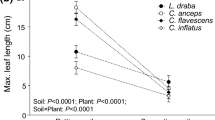Abstract
Experimental work and a survey of literature gave data on the effects of 175 Compositate on populations ofPratylenchus penetrans in the soil. Nearly 70 Compositae effectively suppress populations ofP. penetrans. It is shown that a close relationship exists between this suppressing feature and the chemotaxonomy of the Compositae.
Samenvatting
Eigen onderzoek aangevuld met gegevens uit de literatuur gaf informatie over de invloed van 175 Composieten op populaties vanPratylenchus penetrans in de grond. Bijna 70 soorten verlaagden deze dichtheden (Tabel 1). Het betreft soorten van de geslachtenGrindelia, Solidago, Coreopsis, Eclipta, Rudbeckia, Verbesina, Melampodium, Parthenium, Iva, Ambrosia, Milleria, Baeria, Schkuhria, Eriophyllum, Chaenactis, Helenium, Gaillardia, Tagetes, Arctotis, Gazania, Berkheya, Didelta, Echinops enUrospermum. Er is een duidelijk verband tussen de taxonomische indeling van Composieten en deze eigenschap. Bijna alle getoetste soorten van de subtribus Ambrosiinae, Heleniinae, Arctotinae, Gorteriinae en Echinopinae reduceerden populaties vanP. penetrans. In sommige geslachten zoalsSolidago, Coreopsis, Rudbeckia enMelampodium veroorzaakten slechts een of enkele getoetste soorten dit effect.
Van de 16 Composieten, waarvan bekend is dat zij α-terthienyl in hun wortels bevatten, verlaagden er 15 dichtheden vanPratylenchus. Vrijwel hetzelfde geldt voor Composieten met 5-(3-buteen-1-ynyl)-2,2′-bithienyl in hun wortels (Tabel 1). Ook de aanwezigheid in een aantal andere Composieten van een groep rode dithio-acetyleen-verbindingen met waarschijnlijk nematicide eigenschappen in vitro, komt goed overeen met de eigenschap om dichtheden vanP. penetrans in de grond te verminderen.
Similar content being viewed by others
References
Bohlmann, F., Burkhardt, T. & Zdero, C., 1973., Naturally occurring acetylenes. Academic Press, London and New York, 547 pp.
Bohlmann, F. & Kleine, K.-M., 1965. Polyacetylenverbindungen, LXXXVI. Über rote natürliche Schwefelacetylenverbindungen. Chem. Ber. 98:3081–3086.
Bohlmann, F., Schülz, J. & Bühmann, U. 1969. Struktur und Synthese eines Thymolderivates ausHelenium-Arten. Tetrahedron Lett. 53:4703–4704.
Gommers, F. J., 1971. A nematicidal principle from roots of aHelenium hybrid. Phytochemistry 10: 1945–1946.
Gommers, F. J., 1973. Nematicidal principles in Compositae. Meded. LandbHogesch. Wageningen 73–17.
Gommers, F. J. & Geerligs, J. W. G., 1973. Lethal effect of near ultraviolet light onPratylenchus penetrans from roots ofTagetes. Nematologica 19:389–393.
Hijink, M. J. & Winoto Suatmadji, R., 1967. Influence of different Compositae on population density ofPratylenchus penetrans and some other root-infesting nematodes. Neth. J. Pl. Path. 73:71–82.
Hoffmann, O., 1893. Compositae. In: Engler, H. G. A. & Prantl, K. A. E. (Eds), Die natürlichen Pflanzenfamilien. Engelmann, Leipzig, Bd IV:87–391.
Oostenbrink, M., 1960. Estimating nematode populations by some selected methods. In: Sasser, J. N. & Jenkins, W. R. (Eds), Nematology. Univ. N. Carolina Press, Chapel Hill: 85–102.
Oostenbrink, M., s'Jacob, J. J. & Kuiper, K., 1957. Over de waardplanten vanPratylenchus penetrans. Tijdschr. PlZiekt. 63:345–360.
Takasugi, M., Yachida, Y., Anetai, M., Masamune, T., & Kegasawa, K., 1975. Identification of asparagusic acid as a nematicide occurring naturally in the roots ofAsparagus. Chemy Lett: 43–44.
Townshend, J. L. & Davidson, T. R., 1960. Some weed hosts ofPratylenchus penetrans in premier strawberry plantations. Can. J. Bot. 38:267–273.
Uhlenbroek, J. H. & Bijloo, J. D. 1958. Investigations on nematicides. I. Isolation and structure of a nematicidal principle occurring inTagetes roots. Recl Trav. chim. Pays-Bas Belg. 77:1004–1008.
Uhlenbroek, J. H. & Bijloo, J. D., 1959. Investigations on nematicides. II. Structure of a second nematicidal principle isolated fromTagetes roots. Recl Trav. chim. Pays-Bas Belg. 78:382–390.
Uhlenbroek, J. H. & Bijloo, J. D., 1960. Investigations on nematicides. III. Polythienyls and related compounds. Recl Trav. chim. Pays-Bas Belg. 79:1181–1198.
Author information
Authors and Affiliations
Rights and permissions
About this article
Cite this article
Gommers, F.J., Voorin'tholt, D.J.M. Chemotaxonomy of Compositae related to their host suitability for Pratylenchus penetrans. Netherlands Journal of Plant Pathology 82, 1–8 (1976). https://doi.org/10.1007/BF01977341
Accepted:
Issue Date:
DOI: https://doi.org/10.1007/BF01977341




